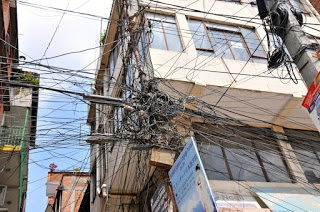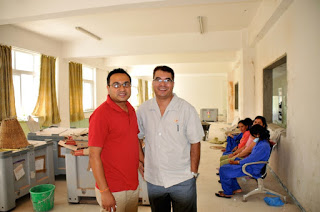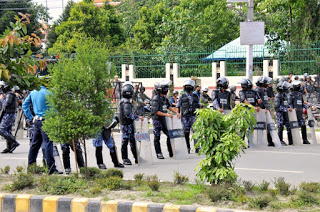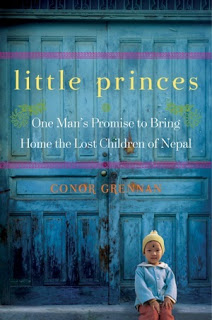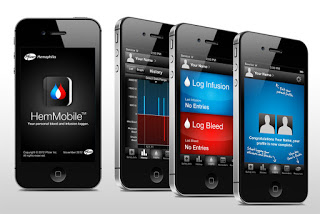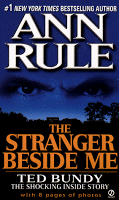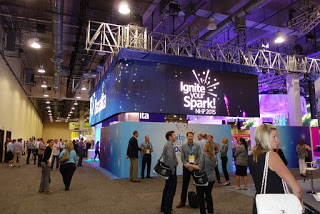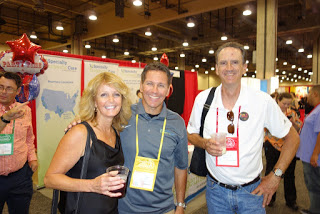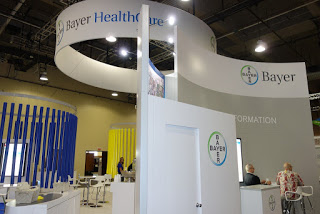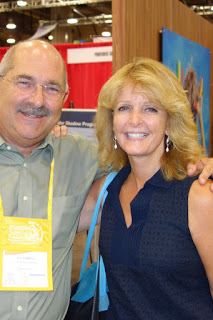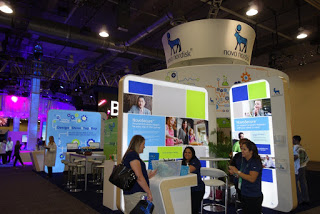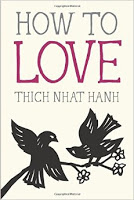Phoenix: Nepal Rises from the Earthquake
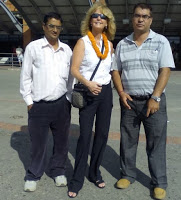 |
| Namste! |
The Nepalese customs official barely looked at my passport–which contained an official visa that expired the next day– smiled, stamped it and wished me
a nice stay. I arrived Sunday evening, August 30 in Kathmandu, capital of this ancient land. The Tribhuvan International airport was fairly devoid of travelers and I collected my two 50 lbs. suitcases,
stuffed with factor and lots of goodies picked up from the NHF meeting we just attended. I walked easily through the
airport and out into the humid evening air. It’s the monsoon season in Nepal, and I expected sheets of rain and puddles to wade through. Luckily the rain held off!
airport with a marigold garland and bouquet of flowers for me; so thoughtful! We greeted each other with the traditional namaste, by placing hands together in prayer fashion.
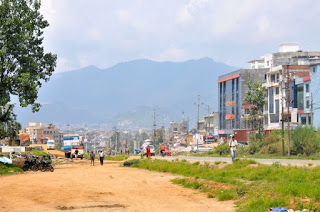 The days start
The days startlate here, which is actually nice and relaxing. I had a 10 am meeting Monday morning at the
NHS office, which is in a gated community. Beda picked me up in a taxi, and I
had my first glimpse of Kathmandu in 14 years. Much has stayed the same:
terrible air quality, leaving my throat raw and my eyes watering. At times you
feel as though your lungs are hooked to an exhaust pipe. About 25% of the people were
surgical filter masks to protect their lungs. I have one but forgot to pack it.
There seem to be more people, heavier traffic, fewer beggars. Motorbikes, cars, rickshaws, trucks all seem to pulse and weave through arteries helter-skelter, belching thick clouds of black exhaust, while above, massive networks of telephone wires and cables lace the streets like
ganglia of nerves. And through this thriving body of humanity, the heat felt
like a fever.
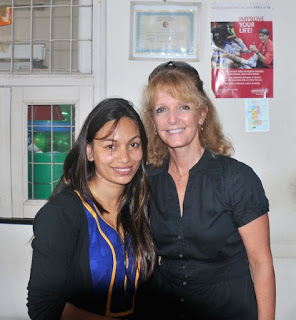 |
| Laxmi Karki and Laurie Kelley |
The shops, buildings and signs are colorful, painting an explosion of sights against the faded blue canvas of the massive hills that encircle Kathmandu. The cows have
mostly been removed; there were so many more in 2000, and it always amuses me
to see, in the midst of the chaotic race of vehicles swerving and maneuvering,
to see a placid cow just standing in the middle of the bedlam, as if it knows it’s holy and trusts it will not be hit.
storing factor.
of chairs, and Beda formally welcomed me, placing another garland of marigolds around
my neck. Present were: Ujjol KC, whose son has hemophilia; Manil
Shrestha, who has hemophilia; Dilli Adhikari, who has factor X; Beda Raj, president
since 2012, who has hemophilia. Shashi, factor IX deficient, treasurer; Guyatri, assistant; and Laxmi Karki, program director.
out, smiling, reached over and offered a hug. Given her warm and welcoming
emails, this fit her style. Next, Dilli glided in, and I have not
seen him in 14 years, since I was last here. He looked the same! Minus a
moustache and sporting a bit of gray at the temples. Nepalese people are very
gentle and soft spoken, mindful of civility and manners at all times. What a
contrast to us in the West!
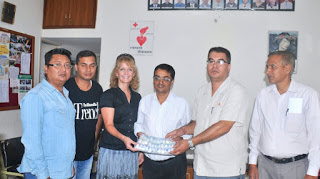 |
| A gift from Project SHARE |
Beda formally welcomed
me, and slipped a red scarf around my
neck, a Hindu greeting. In return, I presented the NHS members with factor from
Project SHARE. Then Beda gave a
presentation, using the wall as a screen. He put time into this presentation. Beda’s
slide show revealed: There are only 2
diagnostic labs; a lack of coag labs means few patients get diagnosed. There
are superstitious beliefs about hemophilia, which often prevent families from
coming in for treatment. There’s no medical support from government. While the
NHS now has opened 5 chapters in “districts,” there is a lack of resources to
develop these district chapters or open more. There are no permanent resources
to develop sustainability; in other words, they struggle mightily for funding.
They do get factor donations, from WFH, SHARE and FBIS (Swedish society, with
whom they were twinned).
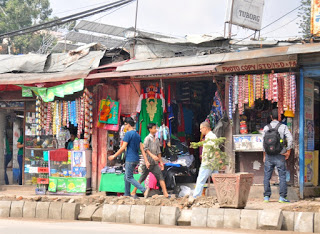 A new national constitution is underfoot; indeed, with 25% of the population not in favor of
A new national constitution is underfoot; indeed, with 25% of the population not in favor ofit, there have been clashes with the police from demonstrations; nine policemen were killed by mobs just before my visit. If ratified, the
constitution will recognize hemophilia at long last. Hemophilia will be
included in the Disability Rights act, as a separate disability—this gives the
NHS a leg to stand on for lobbying and promotion. It would be a massive win for
NHS to have the constitution ratified.
conversation turn to Save One Life. Nepal was our second country to join—a fact which I
had completely forgotten! India was our first; Nepal our second.
Why Nepal? I had been there in 1999 and 2000. I saw the dedication and hard
work of the then newly born NHS. I believed in the staff, and trusted them. My
gut instinct proved correct: they have implemented the program to perfection.
We have 86 beneficiaries, a very high number. There are four scholarships and
one microenterprise grant. Seven patients have their own businesses.
four young men got government jobs. There’s a change in the family concept too:
they realize others care about them, and it helps families to come in to visit
the NHS, be evaluated, and understand NHS and the value of its programs. That’s
just what I envisioned when I developed the program.
to the earthquake. I was curious to know how it affected them; what
happened. I wanted to hear their story. It was deadly. On Saturday,
April 25, at noon, the tectonic plates under the Himalaya shifted, triggering a
massive earthquake registering 7.9 on the Richter scale. For 50 some seconds—an
eternity for an earthquake—homes crumbled, buildings collapsed, people were
crushed.
killed, and more than 23,000 injured. Continued aftershocks occurred throughout Nepal at the intervals of 15–20 minutes,
with one shock reaching a magnitude of 6.7 on 26 April.
hemophilia I had first met in 2000, opened up somberly. “My first thought was
factor: what if they were all lost?” He was honest; factor was the most
important thing to him. “It was so hard for PWHs [patients with hemophilia]. We’re taught to get out fast
when there is an earthquake. But we can’t run, we can’t get out into the open
spaces. We have disabilities. I thought, ‘I should leave my house in one minute
as so, but how?’ Our phones didn’t
work for a couple of hours afterwards. We couldn’t contact one another; it was
frustrating. Eventually everyone lived in tents supplied by the government and
relief agencies.” Manil, educated, polished, lived in a tent for two months.
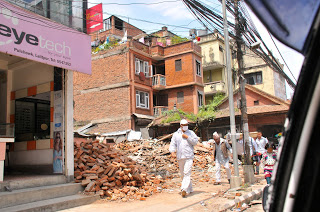 |
| Earthquake damage is seen everywhere |
Barun continued. “We don’t store
factor in our homes; only at the Society office.” Manil added, “Our first thought was factor! After two days,
we were able to get into the office.” There were 15 other earthquakes, and a
recorded 386 aftershocks as of September 2, including one during my visit,
that very night. The aftershocks ensured that the population would live in
tents until there were no more rumblings. More
than three-quarters of the buildings in Nepal’s capital, Kathmandu, were
uninhabitable or unsafe.
Bir Hospital. Injured while running outside, to escape collapse.
“We were mentally distressed,”
admitted Barun. “We needed someone to come and help us, but there was no one.
We were on our own.”
eventually arrived: factor donations from the WFH, Sweden and Project SHARE.
The Mary Gooley Center (now twinned with the Civil Service Hospital) donated $45,000, and
Save One Life raised about $15,000, mostly though Facebook. “But there was no
help at all from our own government,” Barun added.
living in tents, the executive members hired a four-wheel drive vehicle for
$100 a day, and tried to reach families who lived outside the capital city. It took
25 days to see most of the hemophilia families in the field. The tally of
destruction was sobering: out of their known 500 members, 63 homes collapsed. Two
mothers dead. One eight-year-old sister dead.
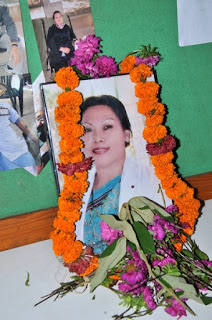 |
| Sanu Maiya Kapali |
The story that saddened them the most was of Sanu, perhaps because of how she died. Sanu Maiya Kapali, mother of a child
with hemophilia, had volunteered at NHS for 10 years, at the care center,
helping the children, consoling the young men in pain. She was a mother-figure
to all. She was conducting a blood donation camp at a hospital, which collapsed.
Blood donations are often done right on the sidewalks, in front of hospitals.
This sounds unsanitary and unsafe, but it’s fast and works for advertising as
the hospitals are typically clogged with patients, doctors and visitors—all
walking by the beds and blood collecting operations. Sanu was outside,
collecting blood to help boost the supply of plasma and cryo for the blood
bank. Huge slabs of concrete fell from the building. She was killed instantly from
falling rubble, along with the two donors she was administering to. Her photo
shows a beautiful woman with a flawless porcelain complexion, dignified smile,
gleaming white teeth, arched eyebrows. Aristocratic, kind. She left behind two
children, one with hemophilia. Everyone knew her, and her death seems to have
left a gaping hole in the strong spirit of the NHS. I realize how deeply bound
everyone here is to one another.
survivors. To date it has distributed donated funds to 56 persons, and wisely
asks for receipts for construction expenses and photos of rebuilding from each
recipient, before administering more. I expressed how glad we were to help, but
I feared they would need more money before the year was out.
more devastating earthquake in 100 years. Barun, not one to hide his feelings,
confirmed: “You’re the first person from the hemophilia community to visit
Nepal. Thank you.”
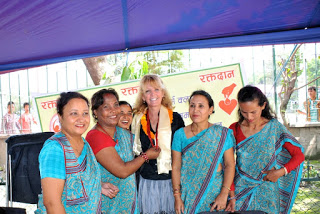 |
| Welcome from the Mother’s Group |
We were running late, and it takes time to
travel anywhere in the crowded city, so we headed for our next meetings, at the
hospitals. There are two hospitals serving hemophilia patients: the Bir
Hospital, and the Civil Services Hospital. The NHS Care Unit at the Bir Hospital
is where most patients go for treatment.
It’s basically a room on the
second floor. I had been here in 2000, and not much had changed. It is a
typical hospital in a developing country: crowded, dark, concrete.
First, outside, we came upon a tent on the
sidewalk with a group of women wearing the same pretty blue saris, and bustling
activity within. As Beda tried to explain what was happening, a dark-skinned
woman with a red tikka on her forehead fairly attacked me with pleasure,
crying, “Welcome! Welcome!” It was Nira, chair of the Mother’s Group. She shook
my hand vigorously, and eventually just hugged me. This is extraordinary
because hugging is not a cultural tradition. She beamed, “I so happy to see you!”
The Mother’s Group was busily signing up pedestrians for blood donations; here was a blood donation
camp happening right in front of me. This was great timing, as I was to learn
later, these only happen twice a year with this energetic group.
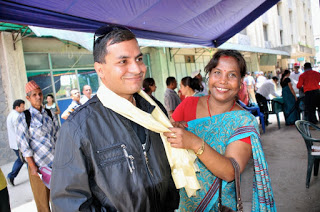 |
| Barun gets a welcome too! |
Like all mothers of children with hemophilia,
we bonded instantly. The warmth of the day penetrated our bodies, and seemed to
emanate outward. Nira quickly took charge. She marshaled the other mothers, who
all welcomed me, and shook hands, some shyly. Making a little ceremony on the
spot, she organized the other mothers to stand near me, and then honored me
with a yellow scarf, a Buddhist tradition, while Barun took photos. I now had a
red scarf, a yellow scarf, red beads and a marigold garland about my neck in
the 90 degree heat. I was staring to sweat up a storm.
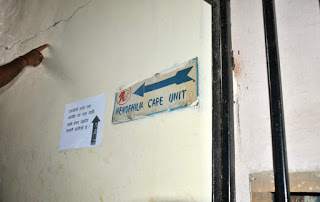 In the midst of our joyous mothers meeting, a
In the midst of our joyous mothers meeting, apoor woman in a yellow outfit lay patiently on a cot, waiting to donate blood.
I worried that we were going to forget about her! But patience is a way of life
in Nepal. Beside her was a man, needle in his arm—a doctor! And hematologist no
less, donating blood outside in the blistering heat on his lunch break. He
smiled for the camera.
Beda pointed out the cracks in the walls from the earthquake. Considering the
whole building is made of this dense and heavy concrete, it was a bit disconcerting.
On the first floor, sections were being pulled apart to rebuild again.
Construction was happening everywhere; rubble was everywhere. Plastic walls
were tacked up to feign protection from dust.
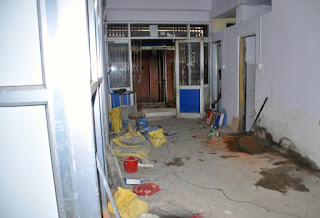 |
| The hospital was damaged |
I took note of the sorry little sign that
read “Hemophilia Care Unit,” nailed to the crumbling wall, and vowed to bring, on my next trip, a new
sign. In the care unit, two patients were receiving treatment. A teen and a
young boy. Before greeting them, the team was anxious to show us Sanu’s photo. The
photo was treated with great respect and placed gently and carefully on a
table, hear the infusion tables. We draped the marigold garlands on it and
several people clasped hands in prayer and bowed to her photo. To me, to us,
she was like a gentle warrior, fighting against pain and suffering, who died in
battle.
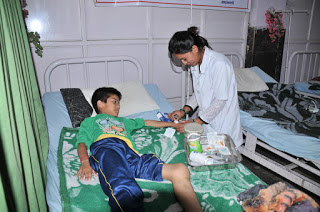 |
| Getting an infusion |
Our next stop was the Civil Service Hospital,
a government hospital. We were immediately greeted
by the friendly and hyperkinetic Dr.
Bishesh Poudyal, casually dressed in a red shirt and khakis, which suited him
and his high energy level. He works at three hospitals, consults
and handles all hematology/oncology cases. The list of his activities and travels
were astounding. I had to almost run to keep up with him as he darted through
the hospital, giving me the 20-minute tour. He had a plane to catch to the Philippines!
At the end, after introducing me to one of his colleagues, he expressed his
immense gratitude for Project SHARE. “You’ve given us a lot of factor over
time,” he reminded me. “You’ve really helped us to save lives here. Thank you.”
so bright that I had to wear sunglasses at all times. Clothes stuck to my skin;
wearing a skirt is brilliant in these climates, or wearing a salwar kameez,
with its absorbent cotton. Unfortunately, I had not packed any of these from my
previous trips. We decided, now that it was 3 pm, to have lunch. None of us had
eaten in seven hours. A restaurant was close by so we decided to walk. Barun
had his motorbike, and looked dashing with his black jacket and dark sunglasses. Beda, who had trouble walking, hopped
on back and met us there. We walked through a dirt lot, onto a major avenue,
where we were surprised to see a few policemen, in their blue camouflage
uniforms, with guns. As we walked we spied more. And more. Pretty soon, we were
gazing upon a riot squad, compete with shields, helmets and armored vehicle.
policemen who was only too glad to chat with the charming girl. She told me,
“There are protesters coming down the street. The police are hoping it is peaceful.”
But the armaments proved they were prepared for the worst. We climbed the
stairs to the second floor and sat at a banquet and ordered Cokes. I could see
from my seat the riot squad. I hope this would not be our entertainment at
lunch. Fortunately, nothing came of it. In fact, despite the 60 or so
policeman, I never saw a single protester.
of Nepal. I let my hosts order for me. Wary of too spicy food, I nibbled this
and that, only once hitting on something that set the tip of my tongue on fire.
Barun sat next to me, and we chatted about his wife, his little boy, how happy
he was to know he would have a boy. “I
was so worried to have a girl,” he confided candidly. “Now, there is no more
hemophilia. I’m not having any more children.” Abortion was legalized only in
2004 in Nepal; it offers a way to end the transmission of hemophilia in countries
where no factor is provided.
Nepal. Compounded with hemophilia and a major earthquake, it is a test of one’s
character, fortitude and faith to continue on. I am amazed at the camaraderie
and above all the joy that bonds everyone together here.
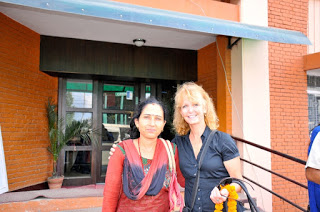 At the end of lunch, we step back into the
At the end of lunch, we step back into theheat and wait for our taxi. One mother keeps catching my gaze; I wasn’t able to
speak with her because he doesn’t know English, and I don’t know Nepalese, more
to the point! Laxmi translated, “She wanted to say thank you for all your help.
She came all the way from her home just to meet you.” Our eyes locked in understanding,
we clasped hands, and she offered a tentative “Tank you” in English. Then we
hugged and took a photo. The power of being with people in person can never be overestimated
in hemophilia. It’s so easy to forget that we have our brothers and sisters in
need elsewhere in the world, when we are seduced and enticed with all the
entertainment and distractions life in developed countries offers. But life here strips away much of this to reveal the basics: connection, caring, sharing.

